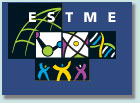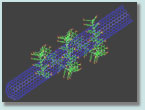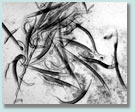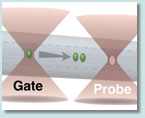| |
 |
 |
 |
|
 |
 |
 |
 |
 |

|
 |
 |
|
|
|
 |
Researchers Spy Stellar Bull's Eye
|
 |
| |
 In the early months of 2002, astronomers scanning the sky saw something highly unusual — and they still don't know exactly what it is. A star suddenly flashed to 600,000 times its previous brightness. For a brief time, it was the brightest star in the galaxy. As the light from the outburst spread into space, it reflected from surrounding rings of dust to reveal a spectacular, multicolored bull's eye that is now 3 light years across and still growing. "This is such an exciting discovery," said NSF-supported astronomer Sumner Starrfield of Arizona State University, one of the researchers reporting the discovery in the March 27 Nature. "It was like a light bulb going off, and you can see the light echoing off surrounding material." In the early months of 2002, astronomers scanning the sky saw something highly unusual — and they still don't know exactly what it is. A star suddenly flashed to 600,000 times its previous brightness. For a brief time, it was the brightest star in the galaxy. As the light from the outburst spread into space, it reflected from surrounding rings of dust to reveal a spectacular, multicolored bull's eye that is now 3 light years across and still growing. "This is such an exciting discovery," said NSF-supported astronomer Sumner Starrfield of Arizona State University, one of the researchers reporting the discovery in the March 27 Nature. "It was like a light bulb going off, and you can see the light echoing off surrounding material."
Image courtesy: NASA, ESA and H.E. Bond (STScI)
Read the full story . ... Posted
3/26/03
|
 |
New Technique Fabricates "Plumbing" for Microfluid Factories
|
 |
| |
 Researchers at the University of Illinois at Urbana-Champaign have devised a new method for fabricating three-dimensional "plumbing" for fluids in millimeter-sized devices, using a robotic pen to draw the pipes with specialized ink. They have used the plumbing to build a mixing factory for microscopic fluid streams, and future applications may include uses in sensors, labs-on-chips and self-repairing materials. The Illinois team reports its findings in the April 2003 Nature Materials. The research is supported by the National Science Foundation, the independent federal agency that supports basic research in all fields of science and engineering, and the Air Force Office of Scientific Research. Researchers at the University of Illinois at Urbana-Champaign have devised a new method for fabricating three-dimensional "plumbing" for fluids in millimeter-sized devices, using a robotic pen to draw the pipes with specialized ink. They have used the plumbing to build a mixing factory for microscopic fluid streams, and future applications may include uses in sensors, labs-on-chips and self-repairing materials. The Illinois team reports its findings in the April 2003 Nature Materials. The research is supported by the National Science Foundation, the independent federal agency that supports basic research in all fields of science and engineering, and the Air Force Office of Scientific Research.
Image courtesy: University of Illinois, Urbana-Champaign
Read the full story . ... Posted
3/24/03
|
 |
President Bush Honors Nation's Top Math and Science Teachers
|
 |
| |
 The White House on March 19 announced the 167 educators to receive the Presidential Award for Excellence in Mathematics and Science Teaching (PAEMST) for 2002. The teachers were greeted by Mrs. Laura Bush today and had their picture taken with her in the East Room of the White House. The White House recognizes the best of the nation's K-12 mathematics and science teachers with this high honor. The award is administered by NSF. “Our nation needs excellent educators at the elementary and secondary levels,” says White House Office of Science and Technology Policy Director and Science Advisor to the President Dr. John Marburger. The White House on March 19 announced the 167 educators to receive the Presidential Award for Excellence in Mathematics and Science Teaching (PAEMST) for 2002. The teachers were greeted by Mrs. Laura Bush today and had their picture taken with her in the East Room of the White House. The White House recognizes the best of the nation's K-12 mathematics and science teachers with this high honor. The award is administered by NSF. “Our nation needs excellent educators at the elementary and secondary levels,” says White House Office of Science and Technology Policy Director and Science Advisor to the President Dr. John Marburger.
Read the full story . ... Posted
3/24/03
List of 2002 Awardees
|
 |
New Measurements Show Silicon Nanospheres Rank Among Hardest Known Materials
|
 |
| |
 University of Minnesota researchers have made the first-ever hardness measurements on individual silicon nanospheres and shown that the nanospheres' hardness falls between the conventional hardness of sapphire and diamond, which are among the hardest known materials. Being able to measure such nanoparticle properties may eventually help scientists design low-cost superhard materials from these nanoscale building blocks. Up to four times harder than typical silicon -- a principal ingredient of computer chips, glass and sand -- the nanospheres demonstrate that other materials at the nanoscale, including sapphire, may also have vastly improved mechanical properties. The researchers' results were published online March 18 by the Journal of the Mechanics and Physics of Solids and will appear in June 2003 issue. The work is supported by the National Science Foundation. University of Minnesota researchers have made the first-ever hardness measurements on individual silicon nanospheres and shown that the nanospheres' hardness falls between the conventional hardness of sapphire and diamond, which are among the hardest known materials. Being able to measure such nanoparticle properties may eventually help scientists design low-cost superhard materials from these nanoscale building blocks. Up to four times harder than typical silicon -- a principal ingredient of computer chips, glass and sand -- the nanospheres demonstrate that other materials at the nanoscale, including sapphire, may also have vastly improved mechanical properties. The researchers' results were published online March 18 by the Journal of the Mechanics and Physics of Solids and will appear in June 2003 issue. The work is supported by the National Science Foundation.
Image courtesy: M.I. Baskes, Los Alamos National Laboratory
Read the full story . ... Posted
3/20/03
|
 |
Web's "Best Meta-Search Engine" Organizes Documents from Anywhere in Any Language
|
 |
| |
 Industry experts at Search Engine Watch recently named Vivísimo the Web's Best Meta-Search Engine for its ability to instantly organize search results into a computer-generated “index.” The software behind Vivísimo's search engine can also be applied to any collection of documents, in languages ranging from English and German to Arabic and Korean. A success story from NSF's Small Business Innovation Research and computer science programs, Vivísimo's Web site was recognized for the second consecutive year for its, "outstanding performance in helping Internet users gather results from many Web search engines by using a single service." Industry experts at Search Engine Watch recently named Vivísimo the Web's Best Meta-Search Engine for its ability to instantly organize search results into a computer-generated “index.” The software behind Vivísimo's search engine can also be applied to any collection of documents, in languages ranging from English and German to Arabic and Korean. A success story from NSF's Small Business Innovation Research and computer science programs, Vivísimo's Web site was recognized for the second consecutive year for its, "outstanding performance in helping Internet users gather results from many Web search engines by using a single service."
Image courtesy: Vivísimo, Inc.
Read the full story . ... Posted
3/20/03
|
 |
Educating for the Future: NSF Joins in ESTME Week Celebration
|
 |
| |
 Excellence in Science, Technology, and Mathematics Education (ESTME) Week was March 16-22, 2003. To celebrate, the Office of Science and Technology Policy of the Executive Office of the President joined with government agencies, including NSF, and societies, organizations and associations to create activities and events to help parents, teachers, and professionals excite K-12 students about science and mathematics. “By challenging and engaging students in these critical fields, we can lay the groundwork for an exciting future of invention, progress and discovery,” noted President George Bush in a message from the White House. Excellence in Science, Technology, and Mathematics Education (ESTME) Week was March 16-22, 2003. To celebrate, the Office of Science and Technology Policy of the Executive Office of the President joined with government agencies, including NSF, and societies, organizations and associations to create activities and events to help parents, teachers, and professionals excite K-12 students about science and mathematics. “By challenging and engaging students in these critical fields, we can lay the groundwork for an exciting future of invention, progress and discovery,” noted President George Bush in a message from the White House.
Read the full story . ... Posted
3/17/03
|
 |
Crystals on a Ball; Researchers
attack 100-year-old puzzle, learn how a single layer of particles
can pack on the surface of a sphere
|
 |
| |
 In a discovery that is likely to impact fields as diverse as medicine and nanomanufacture, researchers have determined how nature arranges charged particles in a thin layer around a sphere. The leap forward in understanding this theoretical problem may help reveal structural chinks in the outer armor of viruses and bacteria (revealing potential drug targets) and guide engineers designing new molecules. In the March 14 issue of the journal Science, researchers describe a major breakthrough in the puzzle, supported by experiments with water droplets and tiny, self-assembling beads. The researchers demonstrate how spherical crystals compensate for the curved surface on which they exist by developing “scars,” defects that allow the beads to pack into place. In a discovery that is likely to impact fields as diverse as medicine and nanomanufacture, researchers have determined how nature arranges charged particles in a thin layer around a sphere. The leap forward in understanding this theoretical problem may help reveal structural chinks in the outer armor of viruses and bacteria (revealing potential drug targets) and guide engineers designing new molecules. In the March 14 issue of the journal Science, researchers describe a major breakthrough in the puzzle, supported by experiments with water droplets and tiny, self-assembling beads. The researchers demonstrate how spherical crystals compensate for the curved surface on which they exist by developing “scars,” defects that allow the beads to pack into place.
Image courtesy: VIrus Particle ExploreR (VIPER) http://mmtsb.scripps.edu/viper/viper.html. From the research of Reddy, V., Natarajan, P., Okerberg, B., Li, K., Damodaran, K., Morton, R., Brooks, C. III, Johnson, J. 2001. J. of Virology 75:11943-11947.
Read the full story . ... Posted
3/13/03
|
 |
University of South Carolina Hosts International Conference on the Global Societal Impacts of Nanoscience
|
 |
| |
 Scholars from the United States and Europe will converge at the University of South Carolina (USC) March 20-23 for the first of two international conferences to discuss the societal implications of nanoscale science and technology on a global scale. The conference is the first ever focusing on "nanoscience studies" -- the examination of the philosophy, ethics, politics, and culture of nanoscience. Opening with a panel discussion of Michael Crichton's recent novel "Prey," the conference features a wide range of papers and discussions. Invited speakers include sociologist Hans Glimell of Göteborg University in Sweden and ethicist Emmanuelle Boubour of Nobel laureate Richard Smalley's research group at Rice University. The conference is supported in part by the National Science Foundation (NSF). Scholars from the United States and Europe will converge at the University of South Carolina (USC) March 20-23 for the first of two international conferences to discuss the societal implications of nanoscale science and technology on a global scale. The conference is the first ever focusing on "nanoscience studies" -- the examination of the philosophy, ethics, politics, and culture of nanoscience. Opening with a panel discussion of Michael Crichton's recent novel "Prey," the conference features a wide range of papers and discussions. Invited speakers include sociologist Hans Glimell of Göteborg University in Sweden and ethicist Emmanuelle Boubour of Nobel laureate Richard Smalley's research group at Rice University. The conference is supported in part by the National Science Foundation (NSF).
Image courtesy: Dr. Richard E. Smalley, Nobel
Laureate for Chemistry, Professor of Chemistry and
Professor of Physics, Rice University
Read the full story . ... Posted
3/13/03
|
 |
With Toxic Crystals, Bacterium Targets -- and Takes out -- Nematodes; Long-time farmers' friend shows promise against parasitic worms
|
 |
| |
 Roundworms, hookworms, watch out. Scientists announced that a soil bacterium's crystal proteins, long an effective weapon against many insect pests, are toxic to some nematodes, too. The crystal proteins -- created by some strains of Bacillus thuringiensis, more commonly known as Bt -- thwart the development of some nematodes and kill others outright. The findings, which appear in the March 4 journal Proceedings of the National Academy of Sciences, raise the possibility that these proteins might one day be used to combat parasitic worms that infect nearly one-fourth of the world's human population. Nematodes -- unsegmented, long, round worms pointed at both ends -- are responsible for illnesses that can lead to elephantiasis of the limbs, intestinal lesions, a type of meningitis and "river blindness." Roundworms, hookworms, watch out. Scientists announced that a soil bacterium's crystal proteins, long an effective weapon against many insect pests, are toxic to some nematodes, too. The crystal proteins -- created by some strains of Bacillus thuringiensis, more commonly known as Bt -- thwart the development of some nematodes and kill others outright. The findings, which appear in the March 4 journal Proceedings of the National Academy of Sciences, raise the possibility that these proteins might one day be used to combat parasitic worms that infect nearly one-fourth of the world's human population. Nematodes -- unsegmented, long, round worms pointed at both ends -- are responsible for illnesses that can lead to elephantiasis of the limbs, intestinal lesions, a type of meningitis and "river blindness."
Image courtesy: Raffi Aroian, UCSD
Read the full story . ... Posted
3/7/03
|
 |
New Procedure Lets Scientists Probe Short-Lived Molecules |
 |
| |
 Some of the most important compounds are the shortest lived -- transient molecules that exist for only thousandths of a second or less during chemical reactions. Characterization of such "reaction intermediates" can play a key role in understanding the mechanisms by which molecules change, shedding light on processes ranging from basic chemical reactions to complex diseases such as Alzheimer's. Yet by their very nature, reaction intermediates exist for periods too brief to be seen by most sensors. Now, in the March 18 Proceedings of the National Academy of Sciences, Jason Shear, an NSF CAREER (Faculty Early Career Development) grantee, and his graduate student Matthew Plenert describe a method for taking quick, microsecond snapshots of these intermediate molecules before the structures change into their more stable end products. Some of the most important compounds are the shortest lived -- transient molecules that exist for only thousandths of a second or less during chemical reactions. Characterization of such "reaction intermediates" can play a key role in understanding the mechanisms by which molecules change, shedding light on processes ranging from basic chemical reactions to complex diseases such as Alzheimer's. Yet by their very nature, reaction intermediates exist for periods too brief to be seen by most sensors. Now, in the March 18 Proceedings of the National Academy of Sciences, Jason Shear, an NSF CAREER (Faculty Early Career Development) grantee, and his graduate student Matthew Plenert describe a method for taking quick, microsecond snapshots of these intermediate molecules before the structures change into their more stable end products.
Image courtesy: Jason Shear, Department of Chemistry & Biochemistry, Institute for Cellular & Molecular Biology, University of Texas at Austin
Read
the full story . ... posted
3/3/03
|
 Top
of Page Top
of Page
|
|
|
 |
 |
 |
 |
 |
 |
 |
 |
|
 |
 |
 |
|
|

